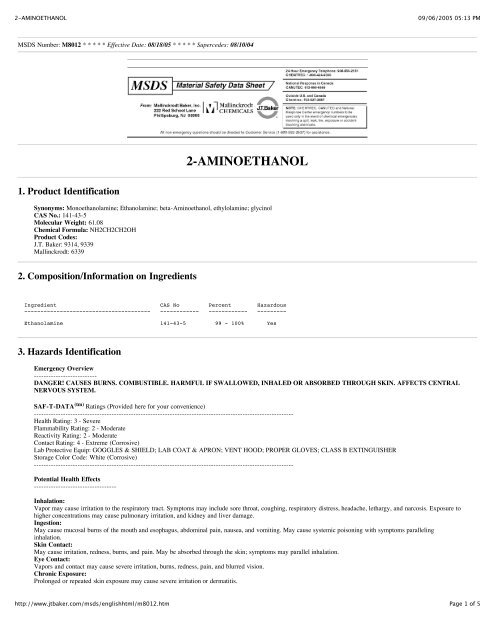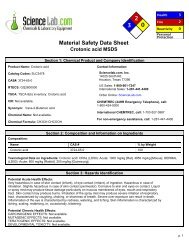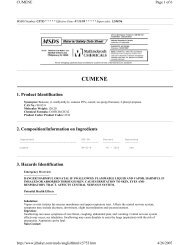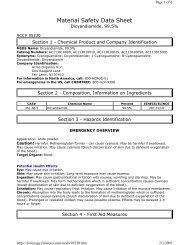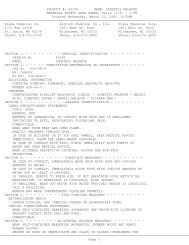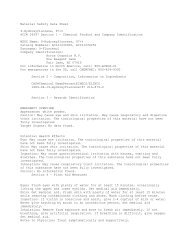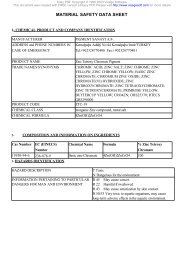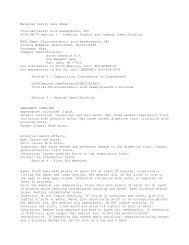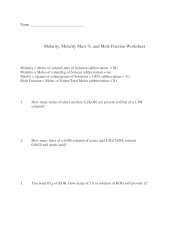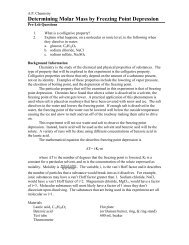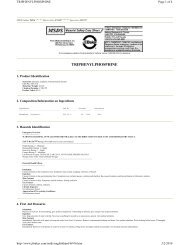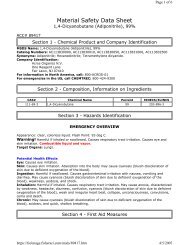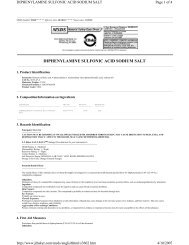MSDS PDF/A/Aminoethanol 2-.pdf
MSDS PDF/A/Aminoethanol 2-.pdf
MSDS PDF/A/Aminoethanol 2-.pdf
You also want an ePaper? Increase the reach of your titles
YUMPU automatically turns print PDFs into web optimized ePapers that Google loves.
2-AMINOETHANOL09/06/2005 05:13 PM<strong>MSDS</strong> Number: M8012 * * * * * Effective Date: 08/18/05 * * * * * Supercedes: 08/10/042-AMINOETHANOL1. Product IdentificationSynonyms: Monoethanolamine; Ethanolamine; beta-<strong>Aminoethanol</strong>, ethylolamine; glycinolCAS No.: 141-43-5Molecular Weight: 61.08Chemical Formula: NH2CH2CH2OHProduct Codes:J.T. Baker: 9314, 9339Mallinckrodt: 63392. Composition/Information on IngredientsIngredient CAS No Percent Hazardous--------------------------------------- ------------ ------------ ---------Ethanolamine 141-43-5 99 - 100% Yes3. Hazards IdentificationEmergency Overview--------------------------DANGER! CAUSES BURNS. COMBUSTIBLE. HARMFUL IF SWALLOWED, INHALED OR ABSORBED THROUGH SKIN. AFFECTS CENTRALNERVOUS SYSTEM.SAF-T-DATA (tm) Ratings (Provided here for your convenience)-----------------------------------------------------------------------------------------------------------Health Rating: 3 - SevereFlammability Rating: 2 - ModerateReactivity Rating: 2 - ModerateContact Rating: 4 - Extreme (Corrosive)Lab Protective Equip: GOGGLES & SHIELD; LAB COAT & APRON; VENT HOOD; PROPER GLOVES; CLASS B EXTINGUISHERStorage Color Code: White (Corrosive)-----------------------------------------------------------------------------------------------------------Potential Health Effects----------------------------------Inhalation:Vapor may cause irritation to the respiratory tract. Symptoms may include sore throat, coughing, respiratory distress, headache, lethargy, and narcosis. Exposure tohigher concentrations may cause pulmonary irritation, and kidney and liver damage.Ingestion:May cause mucosal burns of the mouth and esophagus, abdominal pain, nausea, and vomiting. May cause systemic poisoning with symptoms parallelinginhalation.Skin Contact:May cause irritation, redness, burns, and pain. May be absorbed through the skin; symptoms may parallel inhalation.Eye Contact:Vapors and contact may cause severe irritation, burns, redness, pain, and blurred vision.Chronic Exposure:Prolonged or repeated skin exposure may cause severe irritation or dermatitis.http://www.jtbaker.com/msds/englishhtml/m8012.htmPage 1 of 5
2-AMINOETHANOL09/06/2005 05:13 PMAggravation of Pre-existing Conditions:Persons with pre-existing skin disorders or impaired liver, kidney, and pulmonary function may be more susceptible to the effects of this material.4. First Aid MeasuresInhalation:Remove to fresh air. If not breathing, give artificial respiration. If breathing is difficult, give oxygen. Call a physician.Ingestion:Induce vomiting immediately as directed by medical personnel. Never give anything by mouth to an unconscious person. Call a physician immediately.Skin Contact:In case of contact, immediately flush skin with plenty of water for at least 15 minutes. Remove contaminated clothing and shoes. Wash clothing before reuse. Calla physician.Eye Contact:Immediately flush eyes with plenty of water for at least 15 minutes, lifting lower and upper eyelids occasionally. Get medical attention immediately.5. Fire Fighting MeasuresFire:Flash point: 85C (185F) CCAutoignition temperature: 410C (770F)Flammable limits in air % by volume:lel: 5.5; uel: 17Combustible.Explosion:Above flash point, vapor-air mixtures are explosive within flammable limits noted above.Fire Extinguishing Media:Water spray, dry chemical, alcohol foam, or carbon dioxide. Water spray may be used to keep fire exposed containers cool. Water may be used to flush spillsaway from exposures and to dilute spills to non-flammable mixtures.Special Information:In the event of a fire, wear full protective clothing and NIOSH-approved self-contained breathing apparatus with full facepiece operated in the pressure demandor other positive pressure mode.6. Accidental Release MeasuresVentilate area of leak or spill. Remove all sources of ignition. Wear appropriate personal protective equipment as specified in Section 8. Isolate hazard area. Keepunnecessary and unprotected personnel from entering. Contain and recover liquid when possible. Use non-sparking tools and equipment. Collect liquid in anappropriate container or absorb with an inert material (e. g., vermiculite, dry sand, earth), and place in a chemical waste container. Do not use combustiblematerials, such as saw dust. Do not flush to sewer!7. Handling and StorageKeep in a tightly closed container, stored in a cool, dry, ventilated area. Protect against physical damage. Isolate from any source of heat or ignition. Isolate fromoxidizing materials. Avoid contact with copper and copper alloys. Material is suitably handled in stainless steel equipment. Do not use aluminum for storage ofaqueous solutions. Outside or detached storage is preferred. Isolate from acidic materials. Monoethanolamine is generally stored in plain steel equipment. Productmay solidify at room temperature. Containers of this material may be hazardous when empty since they retain product residues (vapors, liquid); observe allwarnings and precautions listed for the product.8. Exposure Controls/Personal ProtectionAirborne Exposure Limits:2-<strong>Aminoethanol</strong>:-ACGIH Threshold Limit Value (TLV):3 ppm (TWA) 6 ppm (STEL)Ventilation System:A system of local and/or general exhaust is recommended to keep employee exposures below the Airborne Exposure Limits. Local exhaust ventilation is generallypreferred because it can control the emissions of the contaminant at its source, preventing dispersion of it into the general work area. Please refer to the ACGIHdocument, Industrial Ventilation, A Manual of Recommended Practices, most recent edition, for details.Personal Respirators (NIOSH Approved):If the exposure limit is exceeded and engineering controls are not feasible, a full facepiece respirator with organic vapor cartridge may be worn up to 50 times theexposure limit or the maximum use concentration specified by the appropriate regulatory agency or respirator supplier, whichever is lowest. For emergencies orinstances where the exposure levels are not known, use a full-facepiece positive-pressure, air-supplied respirator. WARNING: Air purifying respirators do notprotect workers in oxygen-deficient atmospheres.Skin Protection:Wear impervious protective clothing, including boots, gloves, lab coat, apron or coveralls, as appropriate, to prevent skin contact.Eye Protection:http://www.jtbaker.com/msds/englishhtml/m8012.htmPage 2 of 5
2-AMINOETHANOL09/06/2005 05:13 PMUse chemical safety goggles and/or a full face shield where splashing is possible. Maintain eye wash fountain and quick-drench facilities in work area.9. Physical and Chemical PropertiesAppearance:Clear, colorless liquid.Odor:Ammonia odor.Solubility:Miscible in water.Density:1.02pH:12.1 (25% solution)% Volatiles by volume @ 21C (70F):0Boiling Point:170C (338F)Melting Point:10C (50F)Vapor Density (Air=1):2.10Vapor Pressure (mm Hg):0.4 @ 20C (68F)Evaporation Rate (BuAc=1):< 110. Stability and ReactivityStability:Stable under ordinary conditions of use and storage. Hygroscopic. Absorbs carbon dioxide. A strong base.Hazardous Decomposition Products:Burning may produce carbon monoxide, carbon dioxide, nitrogen oxides.Hazardous Polymerization:Will not occur.Incompatibilities:Sulfuric acid, hydrochloric acid, acetic acid, carbon dioxide in the air, copper, copper alloys, galvanized iron, aluminum, acetic anhydride, acrolein, acrylic acid,acrylonitrile, chlorosulfonic acid, epichlorohydrin, hydrofluoric acid, mesityl oxide, nitric acid, oleum, beta-propiolactone, and vinyl acetate.Conditions to Avoid:Heat, flame, other sources of ignition.11. Toxicological InformationOral rat LD50: 1720 mg/kg; Inhalation mouse LC50: 2420 mg/m3/2hr; Skin rabbit LD50: 1000 mg/kg Irritation data: Skin rabbit - 505 mg moderate; Eye rabbit -0.250 mg severe. Investigated as a mutagen and reproductive effector.--------\Cancer Lists\---------------------------------------------------------NTP Carcinogen---Ingredient Known Anticipated IARC Category------------------------------------ ----- ----------- -------------Ethanolamine (141-43-5) No No None12. Ecological InformationEnvironmental Fate:When released into the soil, this material may biodegrade to a moderate extent. When released into the soil, this material may leach into groundwater. Whenreleased into water, this material may biodegrade to a moderate extent. This material has an estimated bioconcentration factor (BCF) of less than 100. Thismaterial is not expected to significantly bioaccumulate. When released into the air, this material is expected to be readily degraded by reaction withphotochemically produced hydroxyl radicals. When released into the air, this material is expected to have a half-life of less than 1 day. When released into the air,this material may be removed from the atmosphere to a moderate extent by wet deposition.Environmental Toxicity:No information found.13. Disposal ConsiderationsWhatever cannot be saved for recovery or recycling should be managed in an appropriate and approved waste facility. Although not a listed RCRA hazardouswaste, this material may exhibit one or more characteristics of a hazardous waste and require appropriate analysis to determine specific disposal requirements.Processing, use or contamination of this product may change the waste management options. State and local disposal regulations may differ from federal disposalhttp://www.jtbaker.com/msds/englishhtml/m8012.htmPage 3 of 5
2-AMINOETHANOL09/06/2005 05:13 PMregulations. Dispose of container and unused contents in accordance with federal, state and local requirements.14. Transport InformationDomestic (Land, D.O.T.)-----------------------Proper Shipping Name: ETHANOLAMINEHazard Class: 8UN/NA: UN2491Packing Group: IIIInformation reported for product/size: 465LBInternational (Water, I.M.O.)-----------------------------Proper Shipping Name: ETHANOLAMINEHazard Class: 8UN/NA: UN2491Packing Group: IIIInformation reported for product/size: 465LBInternational (Air, I.C.A.O.)-----------------------------Proper Shipping Name: ETHANOLAMINEHazard Class: 8UN/NA: UN2491Packing Group: IIIInformation reported for product/size: 465LB15. Regulatory Information--------\Chemical Inventory Status - Part 1\---------------------------------Ingredient TSCA EC Japan Australia----------------------------------------------- ---- --- ----- ---------Ethanolamine (141-43-5) Yes Yes Yes Yes--------\Chemical Inventory Status - Part 2\-----------------------------------Canada--Ingredient Korea DSL NDSL Phil.----------------------------------------------- ----- --- ---- -----Ethanolamine (141-43-5) Yes Yes No Yes--------\Federal, State & International Regulations - Part 1\-----------------SARA 302- ------SARA 313------Ingredient RQ TPQ List Chemical Catg.----------------------------------------- --- ----- ---- --------------Ethanolamine (141-43-5) No No No No--------\Federal, State & International Regulations - Part 2\-----------------RCRA- -TSCA-Ingredient CERCLA 261.33 8(d)----------------------------------------- ------ ------ ------Ethanolamine (141-43-5) No No NoChemical Weapons Convention: No TSCA 12(b): No CDTA: NoSARA 311/312: Acute: Yes Chronic: No Fire: Yes Pressure: NoReactivity: No(Pure / Liquid)Australian Hazchem Code: 2RPoison Schedule: None allocated.WHMIS:This <strong>MSDS</strong> has been prepared according to the hazard criteria of the Controlled Products Regulations (CPR) and the <strong>MSDS</strong> contains all of the informationrequired by the CPR.16. Other InformationNFPA Ratings: Health: 3 Flammability: 2 Reactivity: 0Label Hazard Warning:DANGER! CAUSES BURNS. COMBUSTIBLE. HARMFUL IF SWALLOWED, INHALED OR ABSORBED THROUGH SKIN. AFFECTS CENTRALNERVOUS SYSTEM.Label Precautions:Do not get in eyes, on skin, or on clothing.Do not breathe vapor.http://www.jtbaker.com/msds/englishhtml/m8012.htmPage 4 of 5
2-AMINOETHANOL09/06/2005 05:13 PMKeep container closed.Use with adequate ventilation.Wash thoroughly after handling.Keep away from heat and flame.Label First Aid:If swallowed, induce vomiting immediately as directed by medical personnel. Never give anything by mouth to an unconscious person. If inhaled, remove to freshair. If not breathing, give artificial respiration. If breathing is difficult, give oxygen. In case of contact, immediately flush eyes or skin with plenty of water for atleast 15 minutes. Remove contaminated clothing and shoes. Wash clothing before reuse. In all cases call a physician.Product Use:Laboratory Reagent.Revision Information:<strong>MSDS</strong> Section(s) changed since last revision of document include: 3.Disclaimer:************************************************************************************************Mallinckrodt Baker, Inc. provides the information contained herein in good faith but makes no representation as to its comprehensiveness or accuracy.This document is intended only as a guide to the appropriate precautionary handling of the material by a properly trained person using this product.Individuals receiving the information must exercise their independent judgment in determining its appropriateness for a particular purpose.MALLINCKRODT BAKER, INC. MAKES NO REPRESENTATIONS OR WARRANTIES, EITHER EXPRESS OR IMPLIED, INCLUDINGWITHOUT LIMITATION ANY WARRANTIES OF MERCHANTABILITY, FITNESS FOR A PARTICULAR PURPOSE WITH RESPECT TO THEINFORMATION SET FORTH HEREIN OR THE PRODUCT TO WHICH THE INFORMATION REFERS. ACCORDINGLY, MALLINCKRODTBAKER, INC. WILL NOT BE RESPONSIBLE FOR DAMAGES RESULTING FROM USE OF OR RELIANCE UPON THIS INFORMATION.************************************************************************************************Prepared by: Environmental Health & SafetyPhone Number: (314) 654-1600 (U.S.A.)http://www.jtbaker.com/msds/englishhtml/m8012.htmPage 5 of 5


